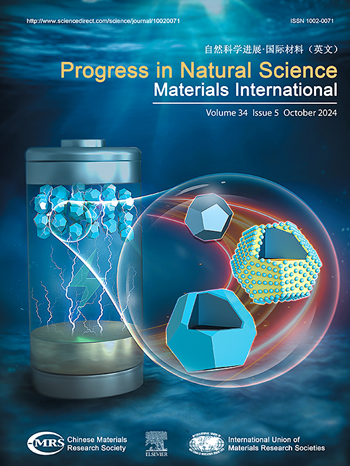Enhanced broadband near-infrared luminescence via phase engineering of Cr3+-doped crystals
IF 7.1
2区 材料科学
Q2 MATERIALS SCIENCE, MULTIDISCIPLINARY
Progress in Natural Science: Materials International
Pub Date : 2025-06-01
DOI:10.1016/j.pnsc.2025.03.009
引用次数: 0
Abstract
As near-infrared spectroscopy technology is increasingly applied in fields such as biomedicine, food detection, and night vision, the demand for efficient near-infrared light sources is growing rapidly. However, traditional light sources, such as tungsten-halogen lamps and supercontinuum lasers, are hindered by low energy efficiency and bulky designs, limiting their suitability for advanced optical applications. Fluoride-based materials have attracted attention due to their low phonon energy and excellent optical transparency, making them promising candidates for next-generation light sources. Herein, cryolite-structured fluorides were synthesized to investigate their potential as efficient near-infrared emitters. Micron-sized Na3Sc1-xF6: xCr3+ and KyNa3-yScF6: 6 %Cr3+ crystals were prepared via a hydrothermal method. The influence of Cr3+ doping concentration and K+ substitution on crystal structure and luminescent performance were systematically explored. Cr3+ doping was found to induce lattice contraction and stabilize an octahedral crystal field, resulting in broadband near-infrared emission. Additionally, K+ substitution induces a phase transition, further enhancing luminescence and significantly extending fluorescence lifetimes. This work reveals the coupled effects of dopant concentration and structural modification in optimizing luminescent behavior. These findings provide valuable insights and theoretical guidance for the rational design and development of efficient near-infrared LED light sources, addressing essential challenges in advanced optical techniques.
通过相位工程增强Cr3+掺杂晶体的宽带近红外发光
随着近红外光谱技术在生物医药、食品检测、夜视等领域的应用越来越广泛,对高效近红外光源的需求也在迅速增长。然而,传统光源,如钨卤灯和超连续介质激光器,受到低能量效率和笨重设计的阻碍,限制了它们在先进光学应用中的适用性。氟化物基材料由于其低声子能量和优异的光学透明度而引起人们的关注,使其成为下一代光源的有希望的候选者。本文合成了冰晶石结构的氟化物,以研究其作为高效近红外发射器的潜力。采用水热法制备了微米级的Na3Sc1-xF6: xCr3+和KyNa3-yScF6: 6% Cr3+晶体。系统探讨了Cr3+掺杂浓度和K+取代对晶体结构和发光性能的影响。发现Cr3+掺杂可以诱导晶格收缩并稳定八面体晶体场,从而产生宽带近红外发射。此外,K+取代诱导了相变,进一步增强了发光并显着延长了荧光寿命。这项工作揭示了掺杂浓度和结构修饰在优化发光行为中的耦合效应。这些发现为合理设计和开发高效的近红外LED光源提供了有价值的见解和理论指导,解决了先进光学技术中的基本挑战。
本文章由计算机程序翻译,如有差异,请以英文原文为准。
求助全文
约1分钟内获得全文
求助全文
来源期刊
CiteScore
8.60
自引率
2.10%
发文量
2812
审稿时长
49 days
期刊介绍:
Progress in Natural Science: Materials International provides scientists and engineers throughout the world with a central vehicle for the exchange and dissemination of basic theoretical studies and applied research of advanced materials. The emphasis is placed on original research, both analytical and experimental, which is of permanent interest to engineers and scientists, covering all aspects of new materials and technologies, such as, energy and environmental materials; advanced structural materials; advanced transportation materials, functional and electronic materials; nano-scale and amorphous materials; health and biological materials; materials modeling and simulation; materials characterization; and so on. The latest research achievements and innovative papers in basic theoretical studies and applied research of material science will be carefully selected and promptly reported. Thus, the aim of this Journal is to serve the global materials science and technology community with the latest research findings.
As a service to readers, an international bibliography of recent publications in advanced materials is published bimonthly.

 求助内容:
求助内容: 应助结果提醒方式:
应助结果提醒方式:


